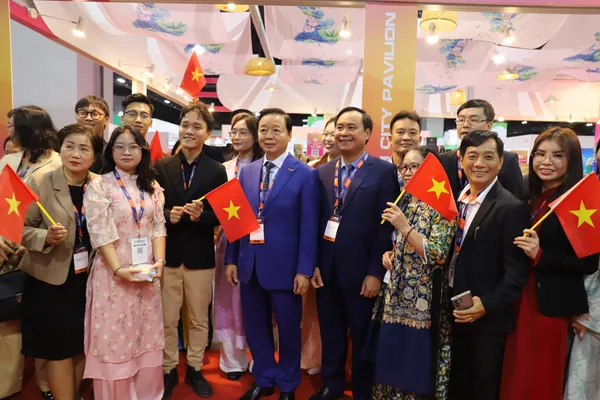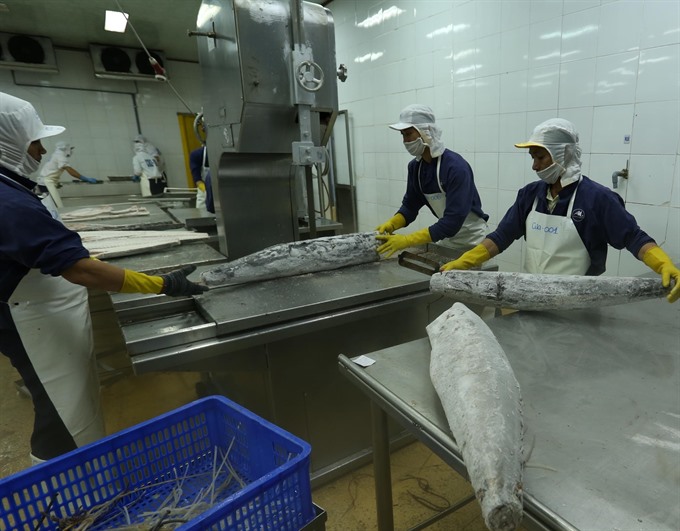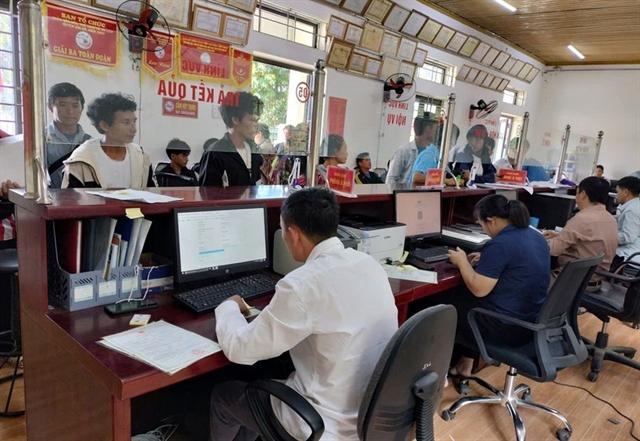 Economy
Economy

Developing concentrated aquaculture areas, strengthening linkages between various links in the value chain, optimising costs, increasing the use of technology, and building brands are among the measures that would add value to the aquaculture sector, according to the Directorate of Fisheries.
 |
| Tuna being processed for export at Bình Định Seafood JSC. — VNA/VNS Photo Vũ Sinh |
HCM CITY — Developing concentrated aquaculture areas, strengthening linkages among stakeholders, optimising costs, increasing the use of technology, and building brands are among the measures that would add value to the aquaculture sector, according to the Directorate of Fisheries.
Speaking at a roundtable in HCM City on Thursday, Trần Đình Luân, deputy general director of the directorate, said aquaculture plays a very important role in the country’s agricultural production and exports.
Productivity and output have increased significantly in recent years, with output exceeding catches from the sea, he said.
Vũ Duyên Hải of the directorate said in the first 10 months of the year fisheries output reached six million tonnes, a year-on-year increase of 6 per cent, with aquaculture accounting for well over half.
“The increase in the use of technology has obviously helped increase aquaculture productivity and output.”
Demand for aquaculture products is expected to continue increasing in the coming years, especially in developing countries, he said.
The free trade agreements the country has signed would throw up opportunities for Vietnamese firms to increase production and export, he said.
But the sector faces challenges, he and other speakers agreed.
Việt Nam is among the world’s largest aquaculture producers and exporters, but its costs are high compared to other countries in the region, they said.
Other challenges included a lack of infrastructure, small scale of farming, intense competition in the global market, technical barriers put up by importing countries, and lack of brands, they added.
Trương Thị Lệ Khanh, chairwoman of Vĩnh Hoàn Corporation, said tra fish exports had increased significantly in recent years, but there are challenges such as a lack of broodstock, labour shortage, rising costs and climate change.
To overcome challenges, she called on enterprises to adopt advanced hatching technologies, automate processing, diversify products and strengthen linkages among stakeholders to cut costs and improve quality.
She also said agencies should provide businesses with timely information about the sector and the market, and run campaigns in the international media to promote the image of Vietnamese tra fish.
Cường said the aquaculture sector should set up farming clusters, restructure production to develop a closed production chain and apply modern technologies.
Trương Đình Hòe, general secretary of the Việt Nam Association of Seafood Exporters and Producers (VASEP), said: “The Government should zone areas for aquaculture and processing plants and identify what species to breed with a focus on encouraging closed production models, linkages in production chains and adoption of modern technologies to improve productivity and reduce costs.”
The sector should acquire aquaculture certificates demanded by large import markets, further clamp down on the use of chemicals and antibiotics, and develop brands, he said.
Lê Văn Quang, chairman and general director of Minh Phú Seafood Corp, the country’s largest shrimp exporter, said: “Large markets such as the US, Japan and the EU do not tolerate antibiotic residues in shrimp.”
The Ministry of Agriculture and Rural Development and the Directorate of Fisheries should intensify checks for antibiotics, he said.
Import markets have demand for various sizes of shrimps whereas Vietnamese farmers usually harvest their shrimp when they reach a size of 30-50 to a kilogramme, leading to a surfeit, while there is a shortage of other sizes, he said.
This should be addressed, he added.
Export increases
The fisheries industry earned $7.4 billion from exports in the first 10 months of the year and would surely meet the full-year target of $9 billion, Hòe said.
Shrimp exports are expected to be worth $3.8 billion and tra fish, $2.2 billion, he said.
“This year, we have made good use of free trade agreements to boost exports. In addition, we have better managed product traceability and the use of antibiotics in farming, meeting the requirements set by importing countries.”
Organised by the directorate, VASEP and GIZ, the event was held to discuss the current situation in the aquaculture sector and measures to improve its efficiency and increase investment in it. — VNS




